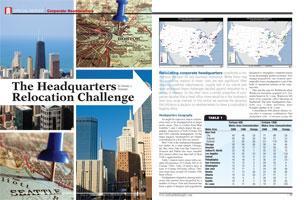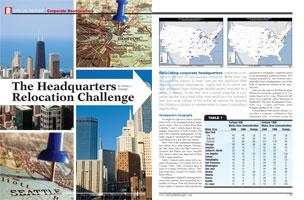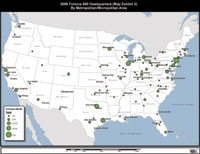

Relocating corporate headquarters constitutes a momentous decision for any business enterprise. While there may be compelling reasons to move, risks are also significant.
After weighing potential risks/rewards, roughly half of our clients who have addressed these challenges decided against relocation for a variety of reasons. On the other hand, a similar proportion of companies decided that a head office move would be in the business’s best long-range interest. In this article we examine the dynamics that influence a decision on whether/where to move a corporation’s flagship office.
Headquarters Geography
As might be expected, major corporations tend to be headquartered in larger metro areas. This is evident from Map Exhibits 1 and 2 which depict the geographic dispersion of both Fortune 500 and 1000 corporate headquarters. As the maps suggest, headquarters are highly concentrated in a few first tier metros.
New York is the undisputed headquarters leader, by a wide margin. Chicago, the Bay Area (San Jose/San Francisco), Houston and Dallas also have sizeable HQ clusters albeit less than half of New York’s agglomeration.
Table 1 below depicts metro areas with a notable HQ presence (10 Fortune 500 or 20 Fortune 1000). Only 14 metros have at least 10 Fortune 500 home offices. Thirteen areas have at least 20 Fortune 1000 head offices.
TABLE 1
Fortune 500 Metro Area Concentration | Fortune 1000 Metro Area Concentration | |||||
Metro Area | 2008 | 1998 | Change | 2008 | 1998 | Change |
New York | ||||||
City | 43 | 46 | (3) | 71 | 68 | |
Suburbs | 30 | 36 | (6) | 50 | 51 | (1) |
Subtotal | 73 | 82 | (9) | 121 | 119 | (4) |
Chicago | 30 | 36 | (6) | 58 | 54 | (4) |
Houston | 26 | 15 | 11 | 55 | 30 | 25 |
Dallas/Ft. Worth | 23 | 16 | 7 | 45 | 32 | 13 |
Los Angeles | 18 | 25 | (7) | 34 | 42 | (10) |
Detroit | 16 | 10 | 6 | 31 | 33 | (2) |
Philadelphia | 16 | 16 | 0 | 30 | 37 | (7) |
San Francisco | 15 | 12 | 3 | 25 | 4 | |
Washington | 15 | 13 | 26 | 17 | 9 | |
San Jose | 13 | 11 | 2 | 24 | 29 | (4) |
Boston | 11 | 15 | (4) | 22 | 26 | (4) |
Atlanta | 10 | 12 | (2) | 21 | 21 | 0 |
Denver | 10 | 5 | 5 | 20 | 20 | 0 |
Seattle | 10 | 9 | 1 | 18 | 20 | (2) |
8 | 11 | (3) | 19 | 31 | (12) | |
 Headquarters migration (among metro areas) has mainly been propelled by a number of forces. First and foremost has been a spate of mergers and acquisitions designed to strengthen competitiveness in an increasingly global economy. Post merger/acquisition, one location automatically loses a headquarters even if the bulk of operations remains at the original sites.
Headquarters migration (among metro areas) has mainly been propelled by a number of forces. First and foremost has been a spate of mergers and acquisitions designed to strengthen competitiveness in an increasingly global economy. Post merger/acquisition, one location automatically loses a headquarters even if the bulk of operations remains at the original sites.
This was the case for Richmond when Wachovia Securities acquired A.G. Edwards based in St. Louis. Wachovia left most of its corporate office functions in Richmond. But pure headquarters functions (e.g. C-suite activities) were brought together in St. Louis.
Consolidation will almost always occur after a corporate combination. But sometimes companies not in an M&A mode will also move headquarters as part of a consolidation initiative (e.g., collocate with decentralized back offices or production facilities). A good example is Pilot Pen which moved headquarters from southern Connecticut to Jacksonville where the firm has a manufacturing presence.
Of course, a few companies whose home offices are situated in expensive (e.g. real estate, labor, cost-of-living) areas will occasionally relocate as part of a cost reduction strategy. Examples include Altria’s move from New York City to Richmond and Kinko’s shift (now part of FedEx) from the LA basin to Dallas.
 Sometimes the reverse is true, with companies actually seeing costs rise in the new location. This is probably no more evident than AOL’s decision to move headquarters from northern Virginia to Manhattan (NYC), the most expensive office location in the country. The overarching need to resuscitate the firm’s leadership in digital media far outweighed the incremental cost for the headquarters operation.
Sometimes the reverse is true, with companies actually seeing costs rise in the new location. This is probably no more evident than AOL’s decision to move headquarters from northern Virginia to Manhattan (NYC), the most expensive office location in the country. The overarching need to resuscitate the firm’s leadership in digital media far outweighed the incremental cost for the headquarters operation.
Proximity/access represented a primary motivation for Louisiana Pacific moving its home base from Portland, OR to Nashville, TN. Rubbermaid’s relocation from Freeport, IL to Atlanta was motivated both by proximity and talent pool. Hilton’s impending move from Beverly Hills to the DC region was motivated by proximity to the lodging industry epicenter (companies/talent base) and ease of air access/travel to key destinations.
HQ relocation doesn’t always pan out. Ford made a decision to collocate its luxury brands (Aston Martin, Jaguar, Land Rover, Volvo and Lincoln Mercury). In addition to Lincoln Mercury’s move (from Dearborn to Orange County, CA), this strategy also involved relocation of both Jaguar and Volvo from New Jersey. The impetus for Lincoln Mercury was to draw fresh design talent, take advantage of synergies with a collocation, and recast the brand’s image. The brand repositioning did not succeed and four years later, Lincoln Mercury moved back to Dearborn (from Irvine). Furthermore Land Rover, Aston Martin and Jaguar are no longer part of the Ford corporate family.
Gateway moved executive offices from North Sioux City to San Diego. Talent infusion to help jump start a stalled company was the driver. But a few years after the move Gateway was gone (acquired by ACER). The move and other actions could not reverse the company’s fortunes.
Exhibit 3 presents a number of corporate relocation examples. For each entry the exhibit displays origin location, new location, and publicly stated reasons for the move. As evident from the exhibit, the preponderance of headquarters moves are not undertaken for cost reasons. That is to say that if there are any savings, they will be insufficient to attain a reasonable payback on the cost of a move. Rather, headquarters relocation decisions tend to be underpinned by more strategic forces such as closer contact with customers or accelerating the pace of change necessary to attain a fresh set of strategic business objectives.
Determining Whether to Relocate
Rationale
The first step in the process is to clearly delineate the business reasons for considering headquarters relocation. These might include one or a combination of the following:
1. Closer proximity to customers, suppliers and company operations
2. Air access
3. Talent acquisition
4. New strategic direction
5. Consolidation
6. Cost reduction
Feasibility
Frequently, top management will want to determine if relocation comprises a viable option. The primary question to be answered is “whether.” If a go decision is approved then the question of “where” is addressed.
A feasibility study embraces the “whether” challenge. The first task it to define the base case. More than likely that will be business as usual (continued operation at the current site or sites).
Accordingly, a profile of the existing location should be developed. This would include headcount, payroll cost, hiring experiences, turnover, office space, occupancy cost, lease expiration, air service/travel patterns, tax liability, existence of incentives with clawback provisions, etc.
Post relocation operating requirements must also be delineated. These include staffing, office space, telecommunications, electric power, air service, furniture/fixtures/equipment investment, etc.
Realizing that loss of employees will happen if a relocation strategy is adopted, it is important to define the most critical positions. These are determined by gauging the tolerance for employee defection, should a move occur. Typically, moved induced attrition should be minimal for positions defined as critical to business continuity. As a rule of thumb, critical positions usually comprise less than 20 percent of total headcount.
Strictly for study purposes, sample locations should be chosen to measure the impacts of a possible move. These locations would reflect logical alternatives but they should not be considered final candidates.
At this stage, another assumption must be agreed upon. That is employee relocation eligibility.
Elements of assistance packages must also be assumed. These include relocation (e.g., a comprehensive package for all or a tiered program, amended or guaranteed home sale, and home sale capital reimbursement) and separation (e.g., stay bonus instead of severance, project completion bonus for selected positions, and outplacement).
At this juncture the impacts associated with relocation are quantified. Note that there could be more than one relocation scenario. Plausible scenarios might include:
1. All employees move
2. Back office functions move but the executive office remains
3. Back office and the C-suite, which might also include sales/marketing, move to separate locations.
For each relocation scenario, the following should be quantified:
1. Employee attrition/retention
2. Recurring costs(and savings vs. base case)
Payroll
Occupancy
Taxes
Other
3. One-time costs
Human resources
o Relocation
o Separation
o Replacement
Real estate
o Space disposition
o Furniture/fixtures/equipment
Disposition
Acquisition
o Office move
o Temporary dual operations
o Transition management (e.g. project staffing, travel, consultants)
o Contingency
4. Payback period
Savings vs. base case
One-time costs
Years to recoup one-time costs
5. Operations improvement
Proximities
Air service
Labor market
Results should be summarized as follows:
1. Relocation rationale
2. Existing location profile
3. Post move operating requirements
4. Relocation scenarios
5. Sample locations
6. Impacts by scenario
Risks
Rewards
7. Move date/timing
8. Competing needs for capital
Other initiatives
Justification for deploying capital for relocation
9. Recommendation
Go
No go
If go,
o Which scenario
o Next steps
- If no go,
o Mitigating existing site disadvantages
o Other measures to address forces motivating a potential move
Location Selection
At this point, top management is in an informed position to ascertain whether relocation comprises a beneficial strategy. If affirmed, then the process moves forward to selecting the best long-range location.
That process is divided into two phases. First is desktop research to identify a shortlist of the most qualified locations. Second is field-based due diligence toassess human resource, quality-of-life, cost, real estate, and other key considerations to determine the location which best serves the operations most critical needs.
The ultimate location will strike a balance among a number of critical and possibly antipodal considerations. These often embrace the following:
1. Nonstop air service/ease of travel
Domestic
International
Travel time to airport
2. Quality-of-life/cost-of-living
Commute distance
Affordable housing
Diverse lifestyle opportunities
Public/private education
Arts/culture
Outdoor recreation
Climate
Crime
Higher education
Personal taxation
Discretionary income
3. National recruiting
Transferring existing employees
Relocating new hires
4. Labor market
Competitive demand
Skillset availability
Keys to employer-of-choice
5. Office space
Best submarkets
Infrastructure
Highway linkage
Mass transit
Parking
Labor proximity
Airport proximity
Lease/own terms and conditions
6. Business operating costs
Multi-year (e.g., 10 year NPV)
Including incentives (offset).
Relative importance of variables such as the above will eventually steer the new HQ to its rightful location. Once that decision is made and announced (again reinforcing corporate strategy) the project enters the implementation phase (moving from whether/where to how).
Conclusions
Headquarters relocation can bring substantial benefits to a corporation. A move presents a unique window of opportunity to introduce significant internal change. Relocation can thus materially impact the achievement of key strategic business objectives.
But relocation carries risk. The principal risk involves potential business disruption due to the loss of valuable employees. This risk can be quantified and frequently programs can be implemented to minimize negative consequences of a move.
The risk/reward equation should be fully understood before a decision to move is made. Then finding the optimal long range location for the business can be addressed. By following a structured and analytical process such as that enumerated above, headquarters relocation can be a significant contributing factor for enhancing a company’s long range success.

